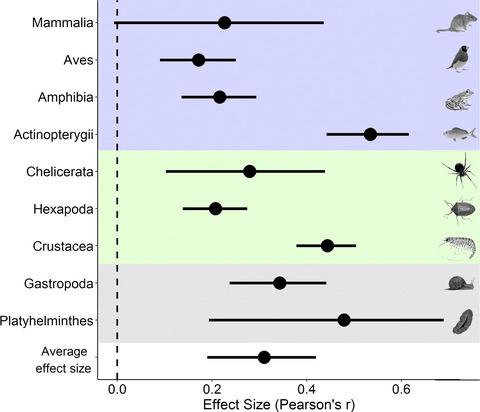当前位置:
X-MOL 学术
›
Ecol. Lett.
›
论文详情
Our official English website, www.x-mol.net, welcomes your
feedback! (Note: you will need to create a separate account there.)
Assortative mating in space and time: patterns and biases
Ecology Letters ( IF 7.6 ) Pub Date : 2021-02-22 , DOI: 10.1111/ele.13690 Rafael Rios Moura 1, 2 , Marcelo Oliveira Gonzaga 2 , Nelson Silva Pinto 3 , João Vasconcellos-Neto 4 , Gustavo S Requena 5
Ecology Letters ( IF 7.6 ) Pub Date : 2021-02-22 , DOI: 10.1111/ele.13690 Rafael Rios Moura 1, 2 , Marcelo Oliveira Gonzaga 2 , Nelson Silva Pinto 3 , João Vasconcellos-Neto 4 , Gustavo S Requena 5
Affiliation

|
Despite the important roles of assortative mating for understanding evolutionary processes, our knowledge on the variation in assortative mating across populations and breeding periods has been overshadowed by the greater attention given to general patterns. Obtaining data on mating pairs are difficult for most species; therefore, researchers often group data from different populations or breeding periods, which can increase positive biases in detecting and estimating assortative mating. We used a meta‐analytic approach to investigate the biases caused by spatially or temporally pooling data and the assortative mating consistency across populations and breeding periods. We describe assortative mating patterns across and within animal taxa. We performed a systematic review to search studies reporting measures of size‐assortative mating (SAM). Grouping data from multiple populations and seasons incurred positive biases. Overall, assortative mating moderately exhibited low repeatability in space and time, but it was inconsistent for most taxa. After excluding pooled measures, the average estimate for assortative mating was moderate and positive. Thus, our findings demonstrate that pooling data can produce misleading results. We also highlight the importance of further investigation of hypotheses that explain spatial and temporal variation in assortative mating, after its detection. Our study reinforces the significance of investigating mating patterns at various spatial and temporal scales before drawing broad conclusions.
中文翻译:

空间和时间的分类交配:模式和偏见
尽管分类交配对于理解进化过程具有重要作用,但我们对跨种群和繁殖期的分类交配变化的了解已被对一般模式的更多关注所掩盖。大多数物种很难获得交配配对数据;因此,研究人员经常对来自不同种群或繁殖期的数据进行分组,这会增加检测和估计相配交配的正偏差。我们使用元分析方法来研究由空间或时间汇集数据引起的偏差以及种群和繁殖期的分类交配一致性。我们描述了动物类群之间和内部的各种交配模式。我们进行了系统审查,以搜索报告大小分类交配 (SAM) 测量的研究。对来自多个人群和季节的数据进行分组会产生正偏差。总体而言,分类交配在空间和时间上适度表现出低重复性,但对于大多数分类群来说是不一致的。在排除汇总措施后,对组合交配的平均估计是中等和积极的。因此,我们的研究结果表明,汇集数据会产生误导性结果。我们还强调了在检测到后进一步研究解释组合交配空间和时间变化的假设的重要性。我们的研究强调了在得出广泛结论之前调查各种空间和时间尺度的交配模式的重要性。但对于大多数分类群来说是不一致的。在排除汇总措施后,对组合交配的平均估计是中等和积极的。因此,我们的研究结果表明,汇集数据会产生误导性结果。我们还强调了在检测到后进一步研究解释组合交配空间和时间变化的假设的重要性。我们的研究强调了在得出广泛结论之前调查各种空间和时间尺度的交配模式的重要性。但对于大多数分类群来说是不一致的。在排除汇总措施后,对组合交配的平均估计是中等和积极的。因此,我们的研究结果表明,汇集数据会产生误导性结果。我们还强调了在检测到后进一步研究解释组合交配空间和时间变化的假设的重要性。我们的研究强调了在得出广泛结论之前调查各种空间和时间尺度的交配模式的重要性。我们还强调了在检测到后进一步研究解释组合交配空间和时间变化的假设的重要性。我们的研究强调了在得出广泛结论之前调查各种空间和时间尺度的交配模式的重要性。我们还强调了在检测到后进一步研究解释组合交配空间和时间变化的假设的重要性。我们的研究强调了在得出广泛结论之前调查各种空间和时间尺度的交配模式的重要性。
更新日期:2021-04-14
中文翻译:

空间和时间的分类交配:模式和偏见
尽管分类交配对于理解进化过程具有重要作用,但我们对跨种群和繁殖期的分类交配变化的了解已被对一般模式的更多关注所掩盖。大多数物种很难获得交配配对数据;因此,研究人员经常对来自不同种群或繁殖期的数据进行分组,这会增加检测和估计相配交配的正偏差。我们使用元分析方法来研究由空间或时间汇集数据引起的偏差以及种群和繁殖期的分类交配一致性。我们描述了动物类群之间和内部的各种交配模式。我们进行了系统审查,以搜索报告大小分类交配 (SAM) 测量的研究。对来自多个人群和季节的数据进行分组会产生正偏差。总体而言,分类交配在空间和时间上适度表现出低重复性,但对于大多数分类群来说是不一致的。在排除汇总措施后,对组合交配的平均估计是中等和积极的。因此,我们的研究结果表明,汇集数据会产生误导性结果。我们还强调了在检测到后进一步研究解释组合交配空间和时间变化的假设的重要性。我们的研究强调了在得出广泛结论之前调查各种空间和时间尺度的交配模式的重要性。但对于大多数分类群来说是不一致的。在排除汇总措施后,对组合交配的平均估计是中等和积极的。因此,我们的研究结果表明,汇集数据会产生误导性结果。我们还强调了在检测到后进一步研究解释组合交配空间和时间变化的假设的重要性。我们的研究强调了在得出广泛结论之前调查各种空间和时间尺度的交配模式的重要性。但对于大多数分类群来说是不一致的。在排除汇总措施后,对组合交配的平均估计是中等和积极的。因此,我们的研究结果表明,汇集数据会产生误导性结果。我们还强调了在检测到后进一步研究解释组合交配空间和时间变化的假设的重要性。我们的研究强调了在得出广泛结论之前调查各种空间和时间尺度的交配模式的重要性。我们还强调了在检测到后进一步研究解释组合交配空间和时间变化的假设的重要性。我们的研究强调了在得出广泛结论之前调查各种空间和时间尺度的交配模式的重要性。我们还强调了在检测到后进一步研究解释组合交配空间和时间变化的假设的重要性。我们的研究强调了在得出广泛结论之前调查各种空间和时间尺度的交配模式的重要性。











































 京公网安备 11010802027423号
京公网安备 11010802027423号